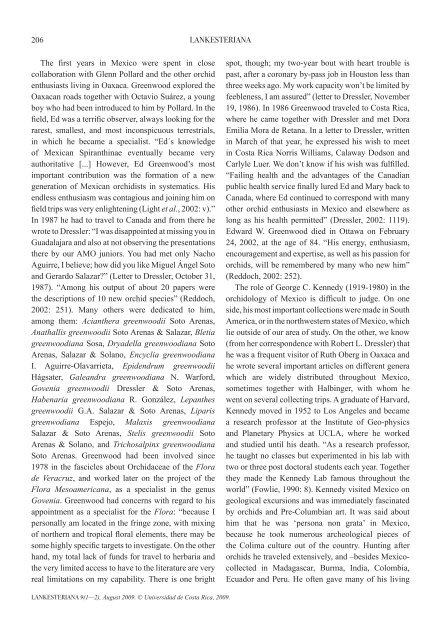orchids and orchidology in central america. 500 ... - lankesteriana.org
orchids and orchidology in central america. 500 ... - lankesteriana.org
orchids and orchidology in central america. 500 ... - lankesteriana.org
Create successful ePaper yourself
Turn your PDF publications into a flip-book with our unique Google optimized e-Paper software.
206<br />
The first years <strong>in</strong> Mexico were spent <strong>in</strong> close<br />
collaboration with Glenn Pollard <strong>and</strong> the other orchid<br />
enthusiasts liv<strong>in</strong>g <strong>in</strong> Oaxaca. Greenwood explored the<br />
Oaxacan roads together with Octavio Suárez, a young<br />
boy who had been <strong>in</strong>troduced to him by Pollard. In the<br />
field, Ed was a terrific observer, always look<strong>in</strong>g for the<br />
rarest, smallest, <strong>and</strong> most <strong>in</strong>conspicuous terrestrials,<br />
<strong>in</strong> which he became a specialist. “Ed´s knowledge<br />
of Mexican Spiranth<strong>in</strong>ae eventually became very<br />
authoritative [...] However, Ed Greenwood’s most<br />
important contribution was the formation of a new<br />
generation of Mexican orchidists <strong>in</strong> systematics. His<br />
endless enthusiasm was contagious <strong>and</strong> jo<strong>in</strong><strong>in</strong>g him on<br />
field trips was very enlighten<strong>in</strong>g (Light et al., 2002: v).”<br />
In 1987 he had to travel to Canada <strong>and</strong> from there he<br />
wrote to Dressler: “I was disappo<strong>in</strong>ted at miss<strong>in</strong>g you <strong>in</strong><br />
Guadalajara <strong>and</strong> also at not observ<strong>in</strong>g the presentations<br />
there by our AMO juniors. You had met only Nacho<br />
Aguirre, I believe; how did you like Miguel Ángel Soto<br />
<strong>and</strong> Gerardo Salazar?” (Letter to Dressler, October 31,<br />
1987). “Among his output of about 20 papers were<br />
the descriptions of 10 new orchid species” (Reddoch,<br />
2002: 251). Many others were dedicated to him,<br />
among them: Acianthera greenwoodii Soto Arenas,<br />
Anathallis greenwoodii Soto Arenas & Salazar, Bletia<br />
greenwoodiana Sosa, Dryadella greenwoodiana Soto<br />
Arenas, Salazar & Solano, Encyclia greenwoodiana<br />
I. Aguirre-Olavarrieta, Epidendrum greenwoodii<br />
Hágsater, Gale<strong>and</strong>ra greenwoodiana N. Warford,<br />
Govenia greenwoodii Dressler & Soto Arenas,<br />
Habenaria greenwoodiana R. González, Lepanthes<br />
greenwoodii G.A. Salazar & Soto Arenas, Liparis<br />
greenwodiana Espejo, Malaxis greenwoodiana<br />
Salazar & Soto Arenas, Stelis greenwoodii Soto<br />
Arenas & Solano, <strong>and</strong> Trichosalp<strong>in</strong>x greenwoodiana<br />
Soto Arenas. Greenwood had been <strong>in</strong>volved s<strong>in</strong>ce<br />
1978 <strong>in</strong> the fascicles about Orchidaceae of the Flora<br />
de Veracruz, <strong>and</strong> worked later on the project of the<br />
Flora Meso<strong>america</strong>na, as a specialist <strong>in</strong> the genus<br />
Govenia. Greenwood had concerns with regard to his<br />
appo<strong>in</strong>tment as a specialist for the Flora: “because I<br />
personally am located <strong>in</strong> the fr<strong>in</strong>ge zone, with mix<strong>in</strong>g<br />
of northern <strong>and</strong> tropical floral elements, there may be<br />
some highly specific targets to <strong>in</strong>vestigate. On the other<br />
h<strong>and</strong>, my total lack of funds for travel to herbaria <strong>and</strong><br />
the very limited access to have to the literature are very<br />
real limitations on my capability. There is one bright<br />
LANKESTERIANA<br />
LANKESTERIANA 9(1—2), August 2009. © Universidad de Costa Rica, 2009.<br />
spot, though; my two-year bout with heart trouble is<br />
past, after a coronary by-pass job <strong>in</strong> Houston less than<br />
three weeks ago. My work capacity won’t be limited by<br />
feebleness, I am assured” (letter to Dressler, November<br />
19, 1986). In 1986 Greenwood traveled to Costa Rica,<br />
where he came together with Dressler <strong>and</strong> met Dora<br />
Emilia Mora de Retana. In a letter to Dressler, written<br />
<strong>in</strong> March of that year, he expressed his wish to meet<br />
<strong>in</strong> Costa Rica Norris Williams, Calaway Dodson <strong>and</strong><br />
Carlyle Luer. We don’t know if his wish was fulfilled.<br />
“Fail<strong>in</strong>g health <strong>and</strong> the advantages of the Canadian<br />
public health service f<strong>in</strong>ally lured Ed <strong>and</strong> Mary back to<br />
Canada, where Ed cont<strong>in</strong>ued to correspond with many<br />
other orchid enthusiasts <strong>in</strong> Mexico <strong>and</strong> elsewhere as<br />
long as his health permitted” (Dressler, 2002: 1119).<br />
Edward W. Greenwood died <strong>in</strong> Ottawa on February<br />
24, 2002, at the age of 84. “His energy, enthusiasm,<br />
encouragement <strong>and</strong> expertise, as well as his passion for<br />
<strong>orchids</strong>, will be remembered by many who new him”<br />
(Reddoch, 2002: 252).<br />
The role of Ge<strong>org</strong>e C. Kennedy (1919-1980) <strong>in</strong> the<br />
<strong>orchidology</strong> of Mexico is difficult to judge. On one<br />
side, his most important collections were made <strong>in</strong> South<br />
America, or <strong>in</strong> the northwestern states of Mexico, which<br />
lie outside of our area of study. On the other, we know<br />
(from her correspondence with Robert L. Dressler) that<br />
he was a frequent visitor of Ruth Oberg <strong>in</strong> Oaxaca <strong>and</strong><br />
he wrote several important articles on different genera<br />
which are widely distributed throughout Mexico,<br />
sometimes together with Halb<strong>in</strong>ger, with whom he<br />
went on several collect<strong>in</strong>g trips. A graduate of Harvard,<br />
Kennedy moved <strong>in</strong> 1952 to Los Angeles <strong>and</strong> became<br />
a research professor at the Institute of Geo-physics<br />
<strong>and</strong> Planetary Physics at UCLA, where he worked<br />
<strong>and</strong> studied until his death. “As a research professor,<br />
he taught no classes but experimented <strong>in</strong> his lab with<br />
two or three post doctoral students each year. Together<br />
they made the Kennedy Lab famous throughout the<br />
world” (Fowlie, 1990: 8). Kennedy visited Mexico on<br />
geological excursions <strong>and</strong> was immediately fasc<strong>in</strong>ated<br />
by <strong>orchids</strong> <strong>and</strong> Pre-Columbian art. It was said about<br />
him that he was ‘persona non grata’ <strong>in</strong> Mexico,<br />
because he took numerous archeological pieces of<br />
the Colima culture out of the country. Hunt<strong>in</strong>g after<br />
<strong>orchids</strong> he traveled extensively, <strong>and</strong> –besides Mexico-<br />
collected <strong>in</strong> Madagascar, Burma, India, Colombia,<br />
Ecuador <strong>and</strong> Peru. He often gave many of his liv<strong>in</strong>g
















